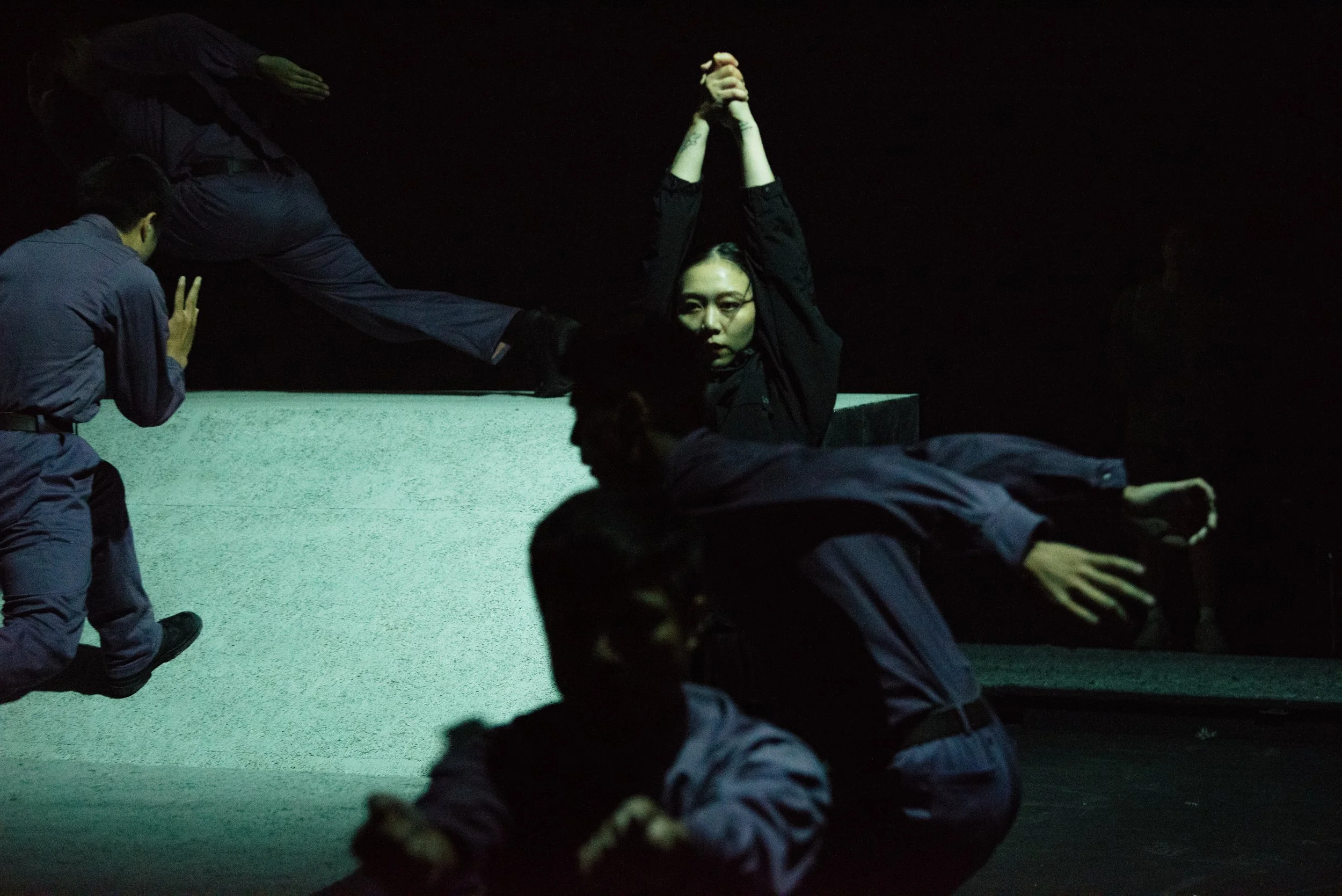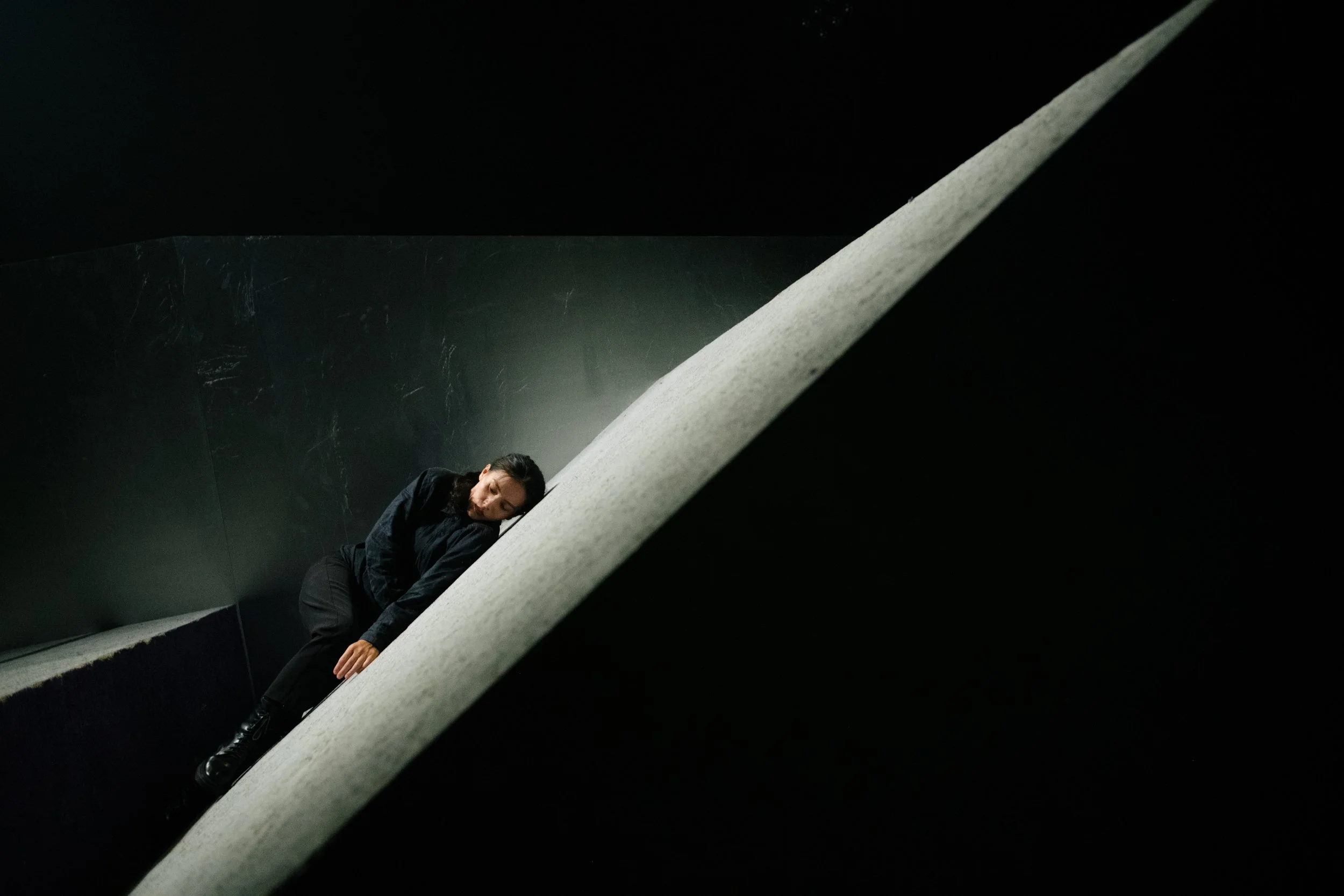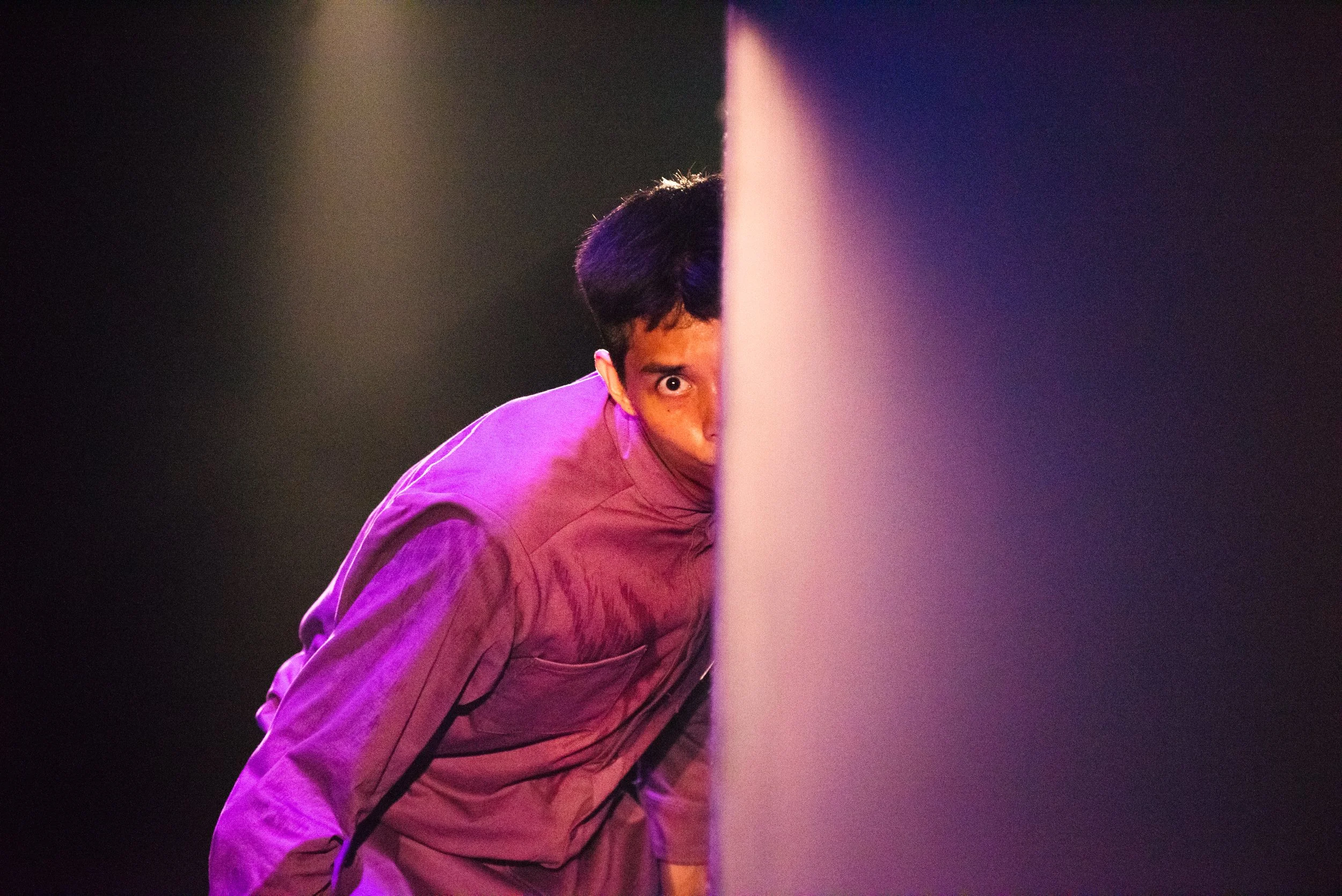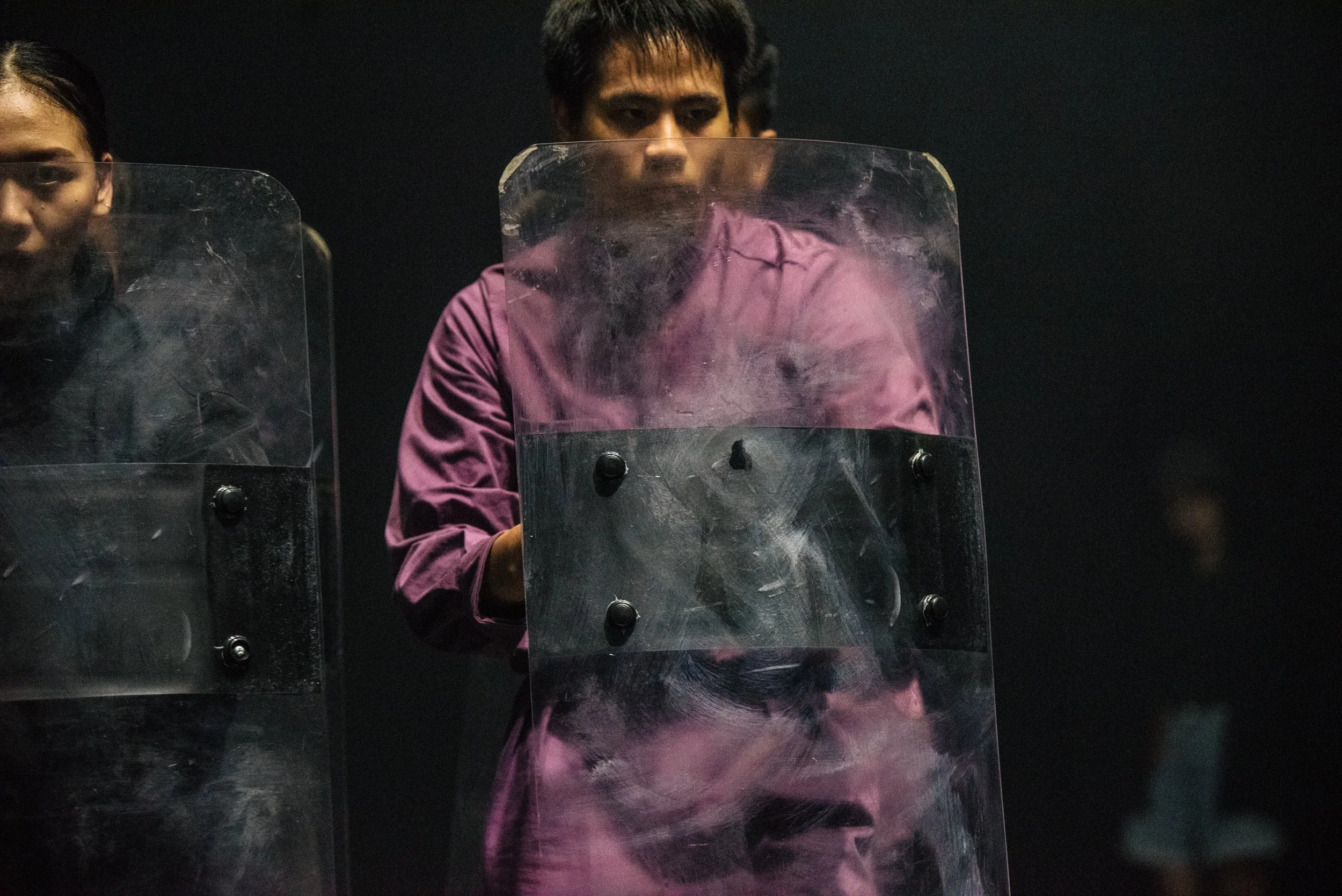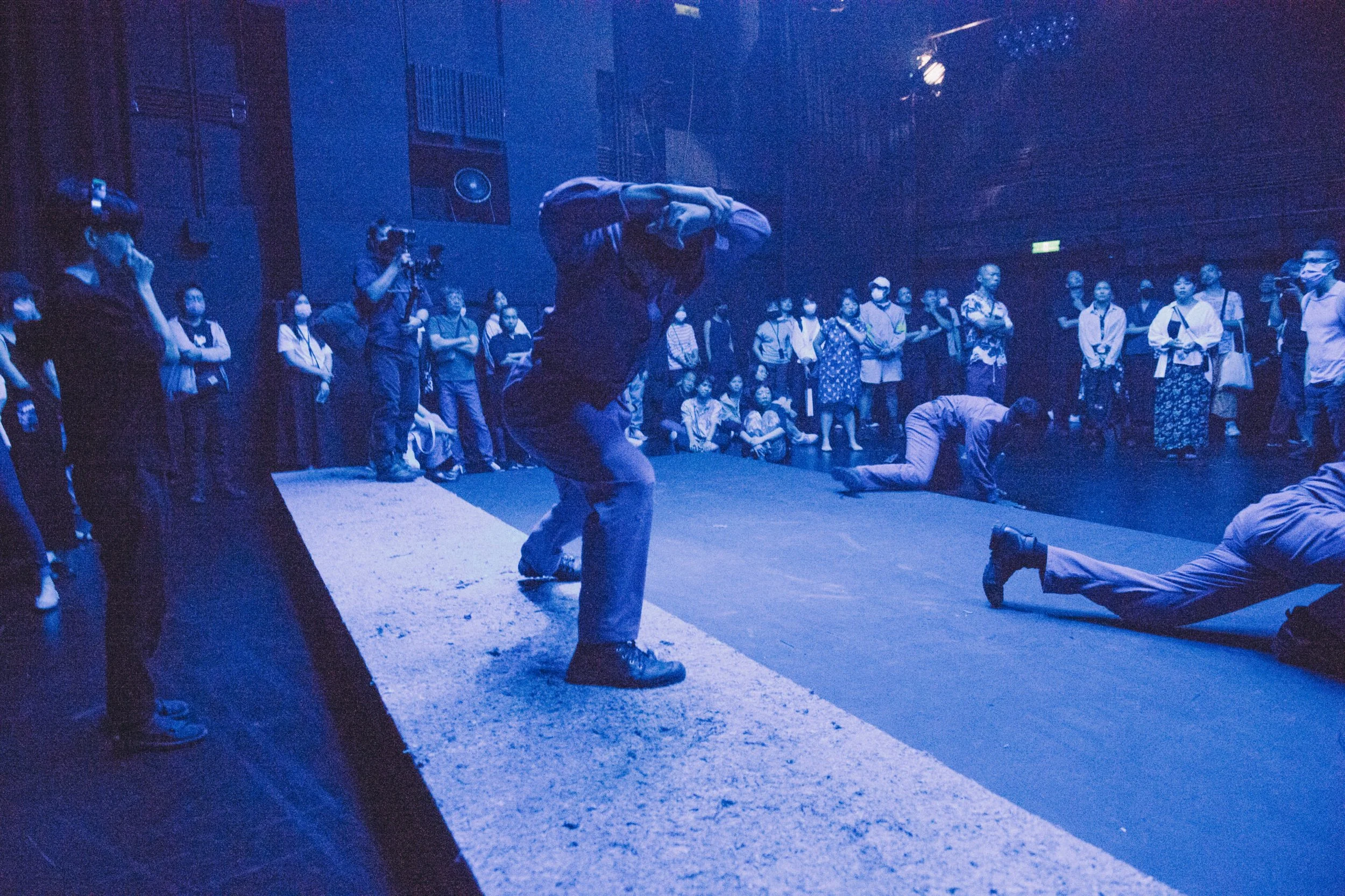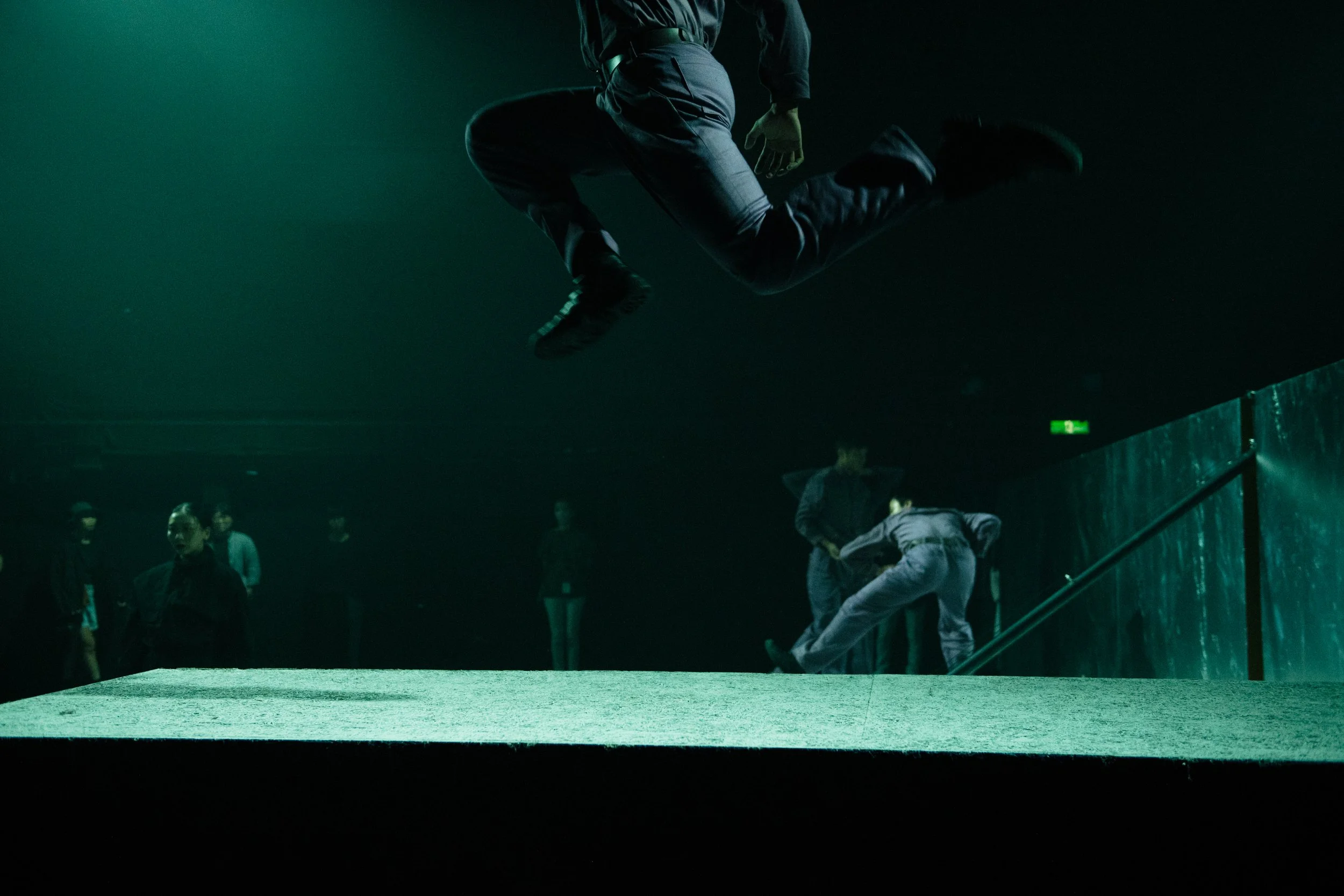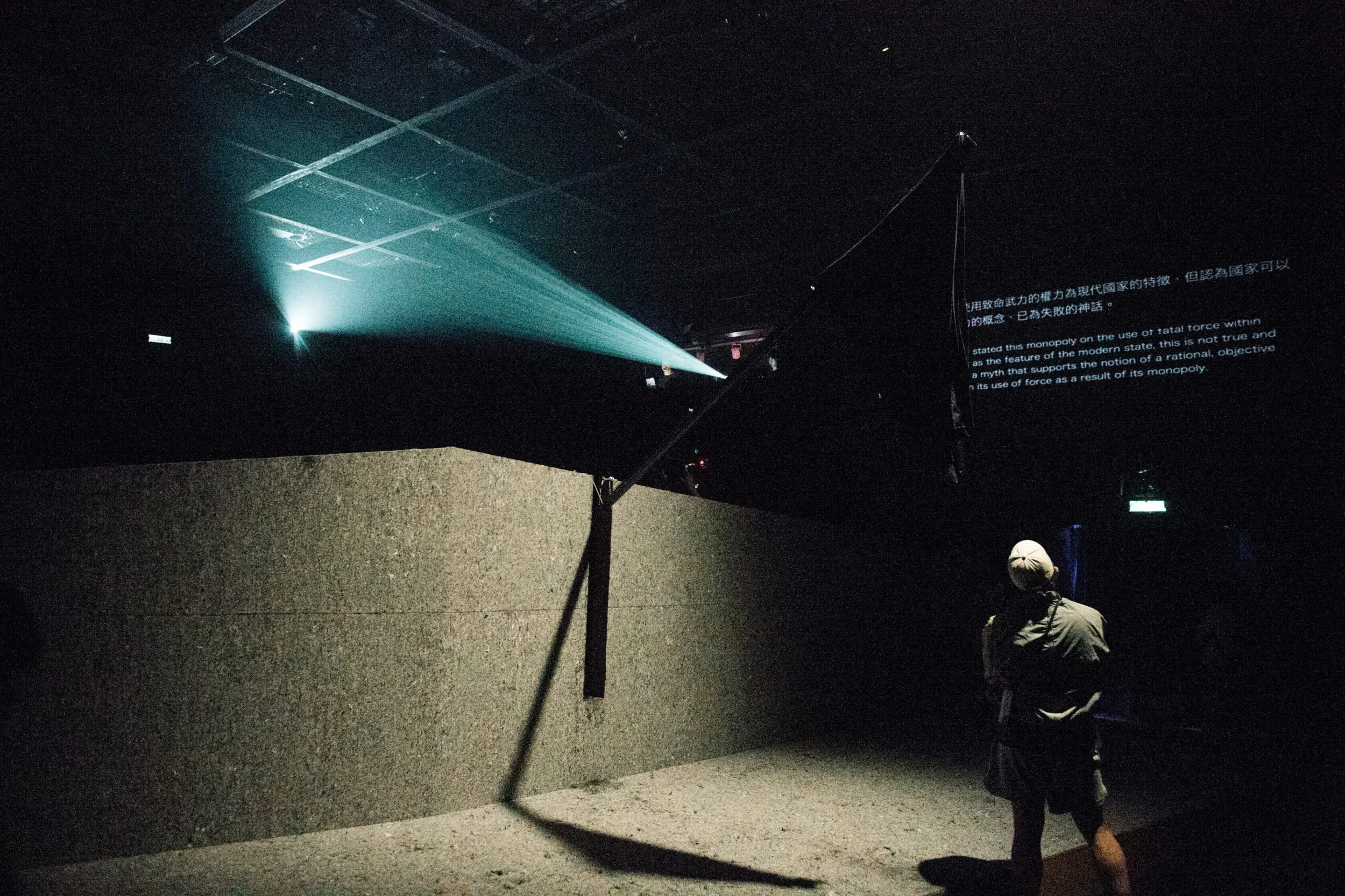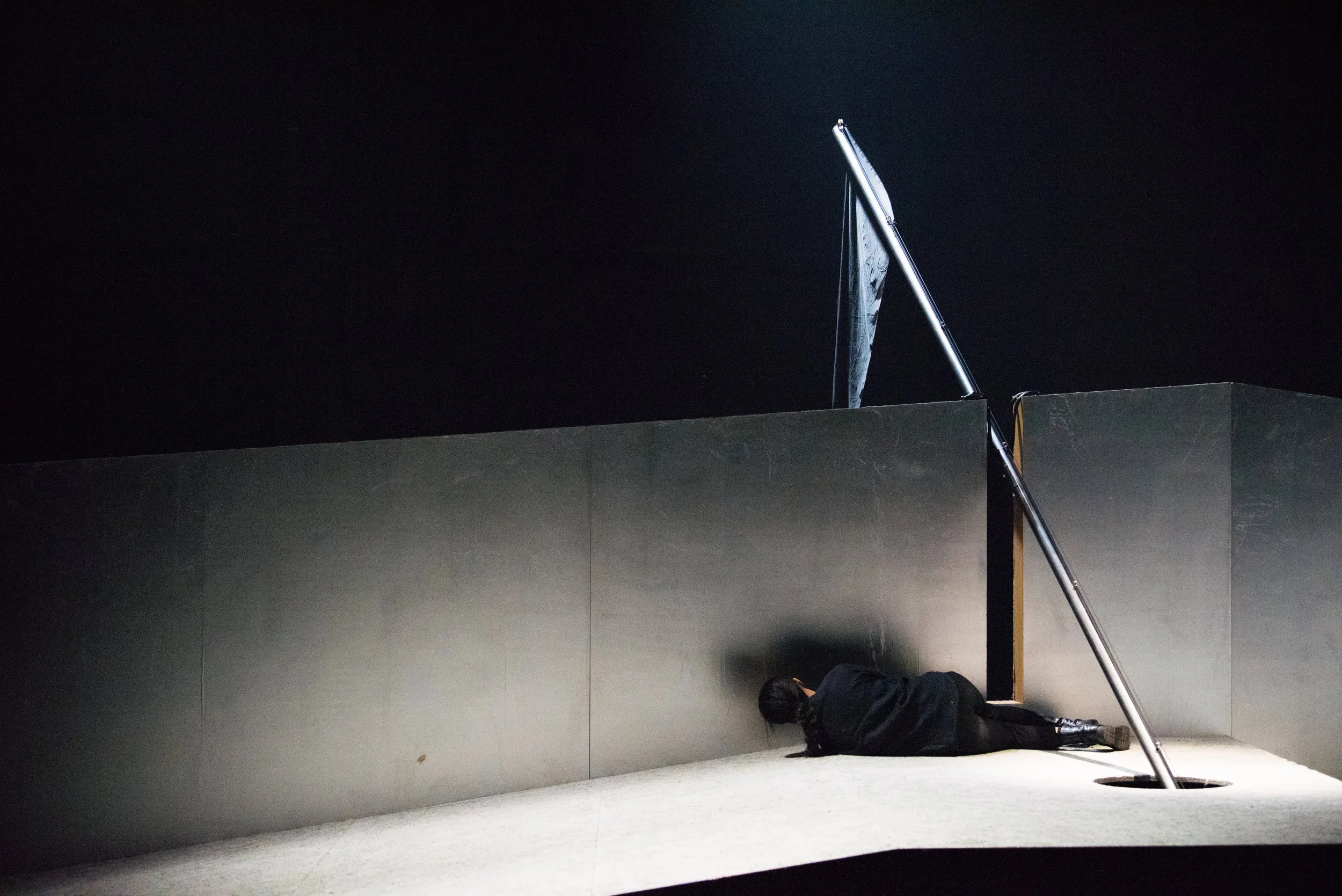Severing, Fracturing, Uniting, Pulverizing, Policing
切割、破裂、凝聚、碾碎、警察
創作顧問 王俊傑
委託製作 兩廳院實驗劇場
導演 李奧森
空間設計 羅智信
燈光設計 曾睿琁
動作設計 亞伯特.賈西亞(Albert Garcia)
造型設計 陳必綺
聲響 羅皓博
表演者 王筑樺、林素蓮、吳立翔、楊智翔、梁俊文、汪冠岳、Albert Garcia、黃敬恆
導演助理 蘇越
舞台監督 林岱蓉
主視覺繪圖 徐笠慈
平面設計 黃嘉宏
攝影 陳藝堂
製作 盧崇瑋
現場錄影 透島影業
贊助 洪建全基金會、覓計畫、建弘文教基金會
Creative Advisor Jun-Jieh Wang
Commission NTCH Experimental Theatre
Director Val Lee
Space Design Jr-Shin Luo
Lighting Design Ray Tseng
Collaborative Movement Design Albert Garcia
Costume Hikky Chen
Sound Hao Luo
Performers Chu-Hua Wang , Sulian Lin, Fly Wu, Wave Yang, Jun-Wen Liang , Guanyue Wang , Albert Garcia, Jingheng Huang
Assistant Director Yue Su
Stage Supervisor Tai-Rong Lin
Main visual drawing Liz Hsu
Graphic Design Jiahong Huang
Photography Etang Chen
On-site recording Toisland Films
Support Hong Foundation, PROJECT SEEK, NSFG Foundation
我拿著證明他人死亡的證件在訊號不通的異地隧道行走,關於氣體、液體、河流與氣溫的死亡。我的佩槍無法發射,白色橡膠手套用來捧起他人四散的形體或是漂流而過的組織,摔練千萬次讓我的臉浮現了另一個人的雛形。其他人在隧道深處演練戰技、策略、連攻,擬定壓制的暴力氣團。我開始奔跑,肺的邊際冒出火花,我拿出進入隧道前領取的手冊,對後面的自己說,「霧太大了,我晚一點到。」
警察系統透過精確與智慧的方式鍛鍊警員,學習體能、體技、大規模事件演習、柔道、警察法,以期達到國家施行權威與控制、維護秩序的能力。他們的權力包括逮補和使用國家授權的合法化武力。導演李奧森透過匿名警員訪談、側繪(profiling)與警察學文獻進行研究,協同動作設計亞伯特.賈西亞(Albert Garcia)及專業表演者發展高強度的動態情境(movement scenarios)與敘事,並運用視覺藝術家羅智信與燈光藝術家曾睿琁共同建構的詩性空間,建構情況不明、無法掌握的事件;與觀者共同思考警察的內在狀態、勞動情境與難以定義的系統性暴力。
I walk through a tunnel with no signal in a foreign place, holding documents certifying the deaths of others—deaths caused by gases, liquids, rivers, and temperatures. My sidearm is unable to fire; white rubber gloves are used to cradle the scattered body parts of others or the body tissues drifting by. Combat throws, practiced ten million times, have infused my face with the contours of another person. The others are deep inside the tunnel, rehearsing combat skills, strategies, and consecutive attacks, conjuring violent air masses for suppression. I start running, sparks of fire flaring at the edges of my lungs. I take out the handbook I received before entering the tunnel and say to the self behind me, "The fog is too thick. I will arrive later."
The artist conducted research through anonymous interviews with police officers, profiling, and studying literature on police science. The work developed high-intensity movement scenarios and narratives and invited the audience to contemplate the inner state of the police, their labor conditions, and the elusive systemic violence they encountered.
Anonymous Police Interview 匿名警察訪談
-
匿名,曾任保安警隊保防組,後進入交通大隊
警員說,保防組學習體能、體技以外,也學逮捕術、靜坐架離。公關一職困難在於認識陌生團體後將內容報告給長官。警員和運動份子都聊得來,困難在於長官時常無法實現交付出去的條件,比如約定好可辦記者會,隨後斷然取消。使用暴力並不會造成困擾,必須適時運用警械。長官依照個人特質挑選公關,隨後也徵求個人意願,警員當初認為公關一職陌生、具有挑戰性。在中正一保防組後期感到疲憊,和運動份子交涉良好,但長官選擇以舉牌、讓行動者跑法院等強制力處理,失去人與人、或是警察與運動者的溝通,工作只剩打探消息的環節;後來自動申請轉離保防組,表示不會再回來。
The officer explained that the Security Division trains in arrest tactics, protester removal, and teamwork. The biggest challenge is liaising with unfamiliar groups and reporting back to superiors. Problems arise when agreements are canceled, such as press conferences. The use of force is part of the job when necessary. Initially, the officer found the liaison role challenging but later became exhausted by it, as superiors relied more on force than dialogue. Eventually, the officer requested a transfer.
A criminal officer, responsible for national policies and gang investigations, specializes in data analysis and crime control. He joined the force due to family hardship and a desire to support his sister’s music education. Interested in subcultures, he keeps a low profile at work. A new SWAT officer, motivated by social injustice, enjoys tracking fugitives. Despite participating in only one raid, he values team rapport, which develops naturally through conversation.
-
匿名,刑警警官
警官說,自己負責全國刑事警察政策,負責偵查;主要專長為幫派組織,負責深入研究、建立數據、分析趨勢,並進行黑道掌控。基層警員以近身訪察作為手段,自己屬中央層級的警官,如果在研究對象的面前坐下,恐怕對方都不會知道自己掌握的程度。警官說自己從警,是因為家庭變故,無法負擔學費,並且想讓妹妹學習音樂。他數次形容自己為左派的警察,並且在警校時就 接觸次文化,樂團、越野車、重型機車,收集美軍基地刺繡外套,對物件質感相當重視。不過行事以低調為原則,避免引起同事關注。
The officer stated that he is responsible for national criminal police policy and investigations, specializing in gang organizations. His work focuses on in-depth research, building data, analyzing trends, and controlling organized crime. While grassroots officers gather information through direct contact, as a central-level officer, he noted that if he were to sit in front of his subjects, they likely wouldn't realize the extent of his knowledge. He mentioned joining the police force due to family hardship—unable to afford tuition and wanting to support his sister’s music education. The officer described himself as a left-leaning policeman, interested in subcultures since police academy days: bands, off-road vehicles, motorcycles, and collecting embroidered jackets from U.S. military bases, paying close attention to material textures. However, he keeps a low profile to avoid attracting attention from colleagues.
-
匿名,霹靂小組新進警員
警員說從小就認為社會有許多不公平,因此一直想當警察,問他是否有遇過什麼事,他說沒有,臉微微地顫抖。警員說之前住在派出所時,下班沒事,就會檢視手上想抓的通緝犯,這是他的興趣,特別是逃逸多年的對象。他透過各大路口的車牌警示器鎖定通緝犯固定通過地點,透過時間點推測對方路線、移動的目的與規律性,就像解數學習題。他會在放假時坐在路口機車上,觀望數個小時,在心裡核對特定車牌、車型、顏色。警員目前僅參與過一次攻堅,對於要固守哪個位置,沒有特別想法,至於攻堅小組之間如何培養眼神、身體與行動默契,他說一起喝茶、聊天,默契就會自然出現。警員身形微胖,不時微笑,帶著內向而固執的氣息,提起原長官不重視他所逮捕的通緝犯,流露出微微的憤怒。
The officer said he wanted to become a policeman because he believed society was full of injustices. When asked if he had experienced anything specific, he said no, his face trembling slightly. Living at the police station, he spent his free time reviewing profiles of long-time fugitives—a hobby of his. Using license plate recognition systems, he tracked suspects' routines, analyzing patterns like solving math problems. On days off, he would watch passing vehicles for hours, matching plates and models in his mind.
He has only taken part in one raid and doesn’t dwell on tactics. He said rapport among team members comes naturally—just through tea and conversation. Slightly heavyset and often smiling, he carries an introverted yet stubborn air. Mentioning former superiors who overlooked his arrests, he showed a flicker of anger.
-
匿名,霹靂小組分隊長
霹靂小組學習戰技、策略、戰術、策略擬定、高樓攀降、壓力測試與小組的團體合作;訓練必須維持強度,透過無劇本方式,配合特殊情境,如棒球場、捷運、會議中心、人犯脅持,反覆對隊員進行壓力測試,以降低錯誤率。劇本由警政署規劃設計,發配維安部隊執行。攻堅時,團隊仰賴手勢、眼神、頭擺溝通。眼神傳遞短訊息,僅有前進與停止,手比數字可能代表門打不開、嫌犯在內等,暗號無固定。攻堅時角色分配為破門手、火力手、盾牌手、指揮官。策略擬定時會掌握嫌犯素行,除非 慣有殺警奪械等棘手狀況,否則警察極少擊斃,因將面臨法院、道德、輿論的高壓檢視。
The SWAT team trains in combat skills, tactics, strategy planning, high-rise rappelling, stress tests, and team coordination. Training is kept intense and unscripted, simulating special scenarios like stadiums, subways, conference centers, or hostage situations, repeatedly testing members under pressure to minimize errors. Scenarios are designed by the National Police Agency and assigned to security units. During raids, the team communicates through hand signals, eye contact, and head movements—eye signals convey simple commands like advance or stop, while hand numbers might indicate obstacles or suspect presence; codes are flexible. Roles include breacher, gunner, shield bearer, and commander. Strategy considers suspect behavior; unless facing extreme cases like cop-killers, officers rarely use lethal force due to legal, ethical, and public scrutiny.
-
匿名,前派出所外勤警員
我與派出所警員認識於藝術場合,隨後約於咖啡店,訪問工作經歷。警員對於我將如何呈現警察感到好奇,她認為所有社會事件背後都有警察行動的痕跡,只是大眾未曾關注,僅偏頗關注警民衝突。她遇過有精神問題的女兒通報母親受傷,但警員至現 場時,母親全身傷痕並已往生。女兒態度相當有攻擊性,甚至挑釁警員,在一段時日偵查後發現為殺害尊親父母案件。因為身為女警,警員隨後協助偵查隊進行審問,此時加害者已近似失魂,眼神總是落在警員頭腦後方。警員認為遇上自殺事件,難免思考為何發生,但處理過於頻繁後,因為流程繁瑣,搜集物件、證據、安撫家屬等,逐漸開始減少思索的時間。無論如何,警察的職責為協助民眾,儘管民眾普遍懷疑眼前警察是否會投入心力,她笑說只有負責開單的交警,獲得最高的尊重。
I met the officer at an art event and later interviewed her at a café. She was curious about how I would portray the police, believing that every social event leaves traces of police action, though the public mostly focuses on police-community conflicts. She recalled a case where a mentally ill daughter reported her mother’s injury, only for the officer to find the mother dead with severe wounds. After investigation, it turned out to be a case of matricide. The officer assisted in interrogating the suspect, who seemed almost soulless. She believes frequent exposure to suicides reduces the time spent pondering them. Despite public skepticism, she joked that traffic officers, who issue tickets, earn the most respect.
-
匿名,警員,台灣警察工作權益推動協會常務理事
警員認為集體分擔的痛苦感較個人 分擔更輕、集體分擔的罪惡感也較為稀薄,因此警察們早已習慣創造數據,好 比報案反應時間,他往往樂意填單註明一秒內抵達,只要不違反正當抵達時 間,無論多荒謬的內容,都不會被檢討。警員在三一八學運時與大學教授筆 戰,對方認為如果體制無法改變現狀,只能尋求體制外的手段達成目的。警員 筆戰失敗後,開始批判與背離主流警察價值觀,思索真正社會意義。他第一 次遇上死亡,為接獲報案:某住宅內散發惡臭、並且不斷漏水,消防隊爬窗進 入後發現,獨居男子的浴室水龍頭持續放水,一男子倒臥房內,屍體已浮腫, 房間積水漂浮著皮膚組織。警員當時連忙開始尋找手機、藥袋或遺書,因為剛 吃完火鍋,內外交雜著衝擊感。
The officer believes collective suffering feels lighter than individual suffering, and collective guilt is less intense. Therefore, police officers are used to creating data, like reporting response times. He often notes he arrived within a second, as long as it doesn’t violate acceptable times, even if it’s absurd. During the Sunflower Movement, he debated with a university professor, who argued that if the system can’t change the status quo, external methods must be used. After losing the debate, the officer began to question and move away from mainstream police values, contemplating the true social meaning. His first encounter with death was when he responded to a report of a foul odor and leaking water from an apartment. The body of a man, who had been living alone, was found in the bedroom, swollen and surrounded by floating skin tissue.
